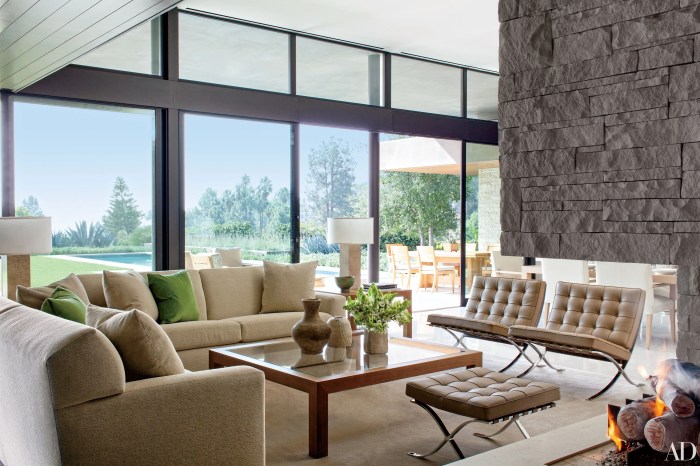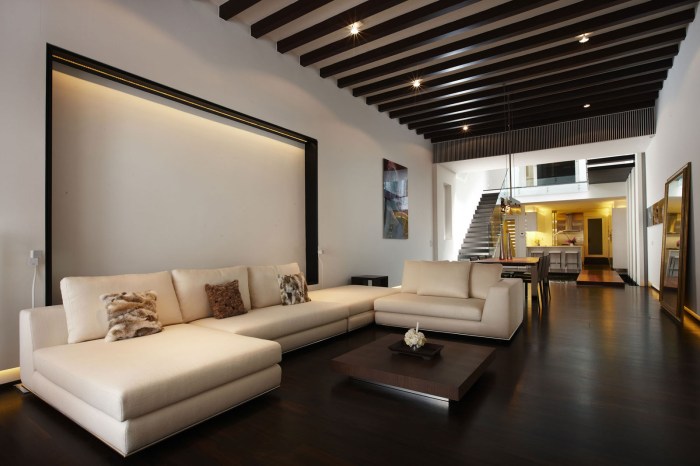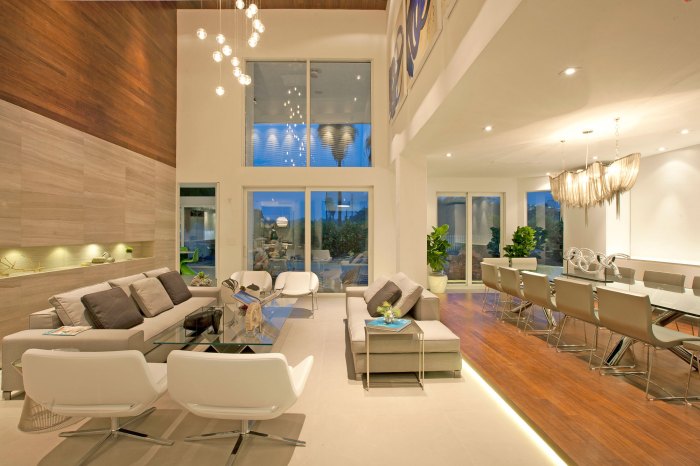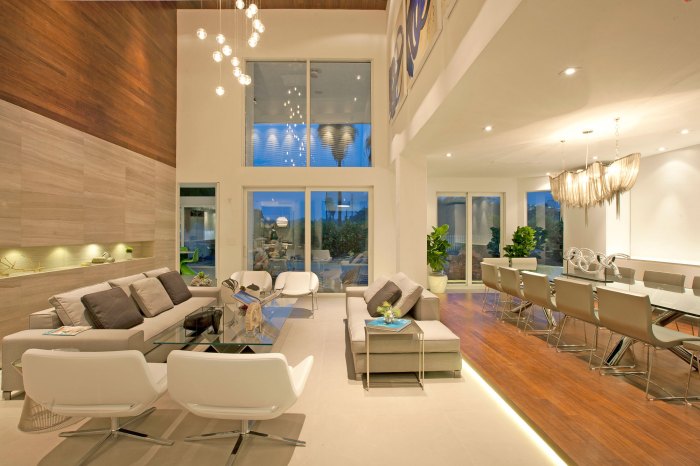Architecture Design: House Interior Secrets
Architecture design house interior is more than just building a structure; it’s about crafting a space that reflects your lifestyle and aspirations. From the initial concept to the final details, every element plays a role in creating a home that’s both beautiful and functional.
This exploration delves into the key principles of architectural and interior design, guiding you through the process of creating a haven that truly feels like home.
This guide will take you on a journey through the intricacies of house design, from understanding architectural styles and interior design principles to selecting materials and finishes that enhance the overall aesthetic and functionality of your home. We’ll also explore the role of technology in modern house design and the growing importance of sustainable practices, ensuring that your dream home is not only stylish but also environmentally conscious.
Choosing Materials and Finishes

The selection of materials and finishes is a crucial step in the architectural design process, as it significantly impacts the aesthetics, functionality, and longevity of the interior space. The choices made in this phase will influence the overall feel and character of the house, while also considering factors such as budget, sustainability, and durability.
Building Materials
The choice of building materials depends on several factors, including the desired aesthetic, budget, and environmental impact. Some common building materials used in house interiors include wood, brick, concrete, and steel. Each material offers distinct advantages and disadvantages.
- Wood: Known for its natural beauty, warmth, and versatility. It is a renewable resource and can be used for various applications, such as flooring, furniture, and structural elements. However, wood can be susceptible to moisture damage, fire, and insect infestation.
- Brick: A durable and fire-resistant material, often used for walls and fireplaces. Brick provides excellent insulation and soundproofing. However, it can be heavy and require skilled labor for installation.
- Concrete: A versatile and durable material that can be molded into various shapes and sizes. It is fire-resistant, water-resistant, and relatively inexpensive. However, concrete can be heavy, prone to cracking, and requires a significant amount of time to cure.
- Steel: A strong and durable material that is often used for structural elements, such as beams and columns. Steel is fire-resistant and can be recycled. However, it can be susceptible to corrosion and requires special coatings for protection.
Sustainable and Eco-Friendly Materials
In recent years, there has been a growing interest in sustainable and eco-friendly building materials. These materials have a lower environmental impact and contribute to a healthier indoor environment. Examples of sustainable materials include:
- Bamboo: A fast-growing, renewable resource that can be used for flooring, furniture, and other applications. Bamboo is lightweight, durable, and has excellent acoustic properties.
- Recycled Materials: Materials such as recycled plastic, glass, and metal can be used to create sustainable building products. Recycled materials reduce the need for virgin resources and minimize waste.
- Cork: A natural, renewable material that is harvested from the bark of cork oak trees. Cork is a sustainable and eco-friendly material that is used for flooring, wall coverings, and insulation.
- Hemp: A fast-growing, sustainable material that can be used for insulation, building panels, and other applications. Hemp is a natural, renewable resource with excellent insulation properties.
Finishes
Finishes play a crucial role in creating the desired aesthetic and functionality of a house interior. They include elements such as paint, flooring, countertops, and window treatments.
- Paint: Paint is a versatile finish that can be used to create a wide range of effects, from subtle to bold. Different paint types offer varying levels of durability, washability, and color retention.
- Flooring: Flooring materials, such as hardwood, tile, carpet, and laminate, can significantly impact the look and feel of a room. Each type of flooring has its own advantages and disadvantages in terms of durability, maintenance, and aesthetics.
- Countertops: Countertop materials, such as granite, quartz, and laminate, provide a functional and aesthetically pleasing surface for kitchens and bathrooms. Each material has its own unique characteristics in terms of durability, stain resistance, and cost.
- Window Treatments: Window treatments, such as curtains, blinds, and shutters, can control light, privacy, and energy efficiency. They also contribute to the overall aesthetic of the space.
Lighting Design for Houses

Lighting design plays a crucial role in shaping the ambiance and functionality of a home. By strategically incorporating different types of lighting, you can create spaces that are both inviting and practical.
Types of Lighting and Their Applications, Architecture design house interior
Lighting in residential spaces can be broadly categorized into three main types: natural light, task lighting, and ambient lighting. Each type serves a distinct purpose and contributes to the overall lighting scheme.
- Natural Light: This type of lighting is derived from the sun and is essential for providing a sense of openness and vitality. It can be maximized through the use of large windows, skylights, and strategically placed mirrors. Natural light is ideal for living areas, kitchens, and bedrooms, as it promotes a sense of well-being and reduces the need for artificial lighting during the day.
- Task Lighting: This type of lighting is designed to illuminate specific areas for focused activities, such as reading, cooking, or working. Task lighting should be bright and focused, using lamps, under-cabinet lighting, or pendant lights. It is crucial to ensure that the light source is positioned correctly to minimize glare and shadows.
- Ambient Lighting: This type of lighting provides general illumination for a space and creates a mood or atmosphere. Ambient lighting can be achieved through overhead fixtures, such as chandeliers, recessed lighting, or track lighting. It is often used to create a warm and inviting ambiance in living rooms, dining rooms, and hallways.
Living Room Lighting Plan
A well-designed living room lighting plan incorporates a combination of natural light, task lighting, and ambient lighting to create a balanced and functional space.
- Natural Light: Large windows or a bay window can be incorporated to maximize natural light. Sheer curtains or blinds can be used to control the amount of light entering the room.
- Task Lighting: Table lamps with adjustable shades can be placed near seating areas to provide focused light for reading or other activities. Floor lamps can be used to illuminate specific corners or artwork.
- Ambient Lighting: A central chandelier or pendant light can provide general illumination. Recessed lighting can be used to highlight architectural features or create a more contemporary feel. Dimmers can be incorporated to adjust the intensity of the ambient lighting and create different moods.
Impact of Lighting on Mood and Ambiance
Lighting has a significant impact on the mood and ambiance of a space. Different types of lighting can evoke a wide range of emotions and feelings.
- Warm White Lighting: Warm white light with a color temperature of 2700-3000K creates a cozy and inviting atmosphere, often used in living rooms, bedrooms, and dining rooms.
- Cool White Lighting: Cool white light with a color temperature of 4000-4500K is more stimulating and energetic, often used in kitchens, bathrooms, and workspaces.
- Dim Lighting: Dim lighting creates a romantic and intimate ambiance, often used in dining rooms, bedrooms, and home theaters.
- Bright Lighting: Bright lighting can make a space feel more spacious and airy, often used in kitchens, bathrooms, and entryways.
Closing Summary

By embracing the principles of architecture design house interior, you can create a space that is not only visually appealing but also reflects your unique personality and needs. Whether you’re seeking a modern minimalist haven or a traditional, cozy retreat, the power of design lies in its ability to transform your vision into a reality.
With careful planning, thoughtful selection of materials, and a touch of creativity, you can create a home that is truly your own – a space that inspires, comforts, and elevates your everyday life.
Questions Often Asked: Architecture Design House Interior
What are some common architectural styles for houses?
Common architectural styles include Victorian, Colonial, Modern, Contemporary, and Mediterranean, each with distinct features and characteristics.
How do I choose the right interior design style for my home?
Consider your personal preferences, lifestyle, and the overall style of your home. Popular styles include minimalist, traditional, farmhouse, and eclectic.
What are some essential furniture pieces for a modern kitchen?
A modern kitchen typically features sleek cabinetry, a large island, bar stools, and stainless steel appliances.
What are some sustainable materials for building a house?
Sustainable building materials include bamboo, recycled wood, straw bale, and recycled plastic.

